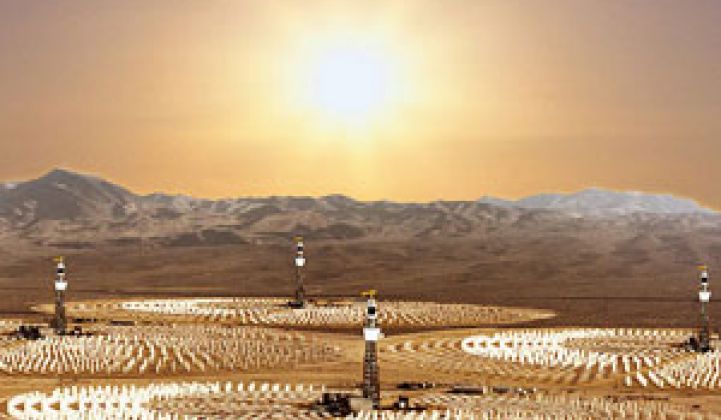Two companies, SolarReserve and Platina Partners, on Tuesday said they have raised project financing to build solar-power plants.
SolarReserve, a Santa Monica, Calif.-based company that develops large solar-power plants for utilities, said Tuesday it has closed $140 million in a second round of funding.
The company is developing power plants that generate electricity from the sun's heat, instead of its light. It uses technology, developed by Hamilton Sundstrand's Rocketdyne division, which stores the heat in molten salt, converting it into energy via steam turbines when it's needed.
Investors include Sustainable Development Investments, which is Citi Alternative Investments' renewable-energy private-equity arm, Credit Suisse's Customized Fund Investment Group, Good Energies, U.S. Renewables Group, PCG Clean Energy & Technology Fund and Nimes Capital LLC.
On the same day, European private-equity fund Platina Partners LLC announced it has closed €128 million (about $181 million) in debt financing for two Spanish photovoltaic projects with the capacity to produce up to 5.7 megawatts and 11.4 megawatts of power.
UniCredit Markets and Investment Banking arranged the financing for Platina Partners' subsidiary Anemoi Renovables S.L., which will manage the solar projects, called Cantillana and El Coronil II.
The financing was closed in May and August. Platina expects both projects to be completed this month.
The company also is building a 2.4-megawatt project, in Ocaña, Spain, that it previously announced in March.
Travis Bradford, president of the Prometheus Institute, said it is unclear, in many of these financing announcements, whether the money has actually been handed over or whether it's based on contingencies or obligations that might or might not be met.
"This is not like being pregnant, where you either are or aren't," he said. "Orders aren't orders, sales aren't sales and contracts aren't contracts, and in this case, it could be that financing isn't financing. I don't know if someone's written a check or if they've written facilities for getting financing under certain conditions; if it's actually happened or if it's something being talked about. Companies are getting very loose about what they're terming commitments."
In other news Tuesday, Chinese solar-panel maker Suntech Power Holdings Co. Ltd. (NYSE: STP) announced it has begun construction on a new solar-cell factory in Yangzhou, China. The plant, expected to reach a capacity of 300 megawatts by the end of 2009, will help bring Suntech's total capacity to 1.4 gigawatts next year and 2 gigawatts by the end of 2010.
It's good news for the company, Bradford said. "Size matters."
Meanwhile, Suniva Inc., an Atlanta-based manufacturer of crystalline-silicon solar cells, said Tuesday that its research team has developed several solar cells in its lab that can convert more than 20 percent of the sunlight that reaches them into electricity.
The milestones have been verified by the National Renewable Energy Laboratory, the company said.
Bradford said high efficiency could be an advantage in the solar market, although it often comes with high cost.
While others, such as SunPower Corp., already produce solar panels with higher efficiencies, 20 percent is "significantly better" than standard mono- and mult-crystalline cells, he said.
"If it turns out to be indicative of the full commercialized product line, it would put them into a small, exclusive class of what I term the 'supermono companies,' a new class of high-efficiency PV cell manufacturers," he said. "It would be great to get there."
At a Greentech Media conference Monday, Bradford said some companies hope to differentiate themselves by targeting higher efficiencies – which result in lower nonpanel costs – and others are targeting lower costs with lower efficiencies, Bradford said (see When Will Solar Be Cost-Competitive?).
He said either proposition could be successful.
"Both could be true, but I wouldn't want to be half of one and half of the other – I'm not the cheapest, nor am I the most efficient," he said. "Frankly, the worst place to be is in the middle. Middle-tier polysilicon players run out of profit first."



